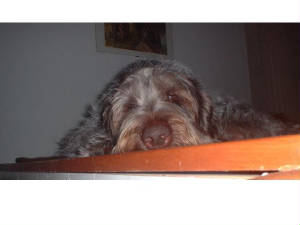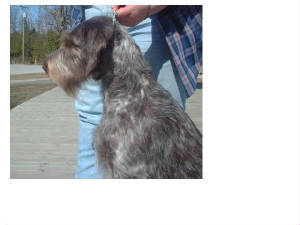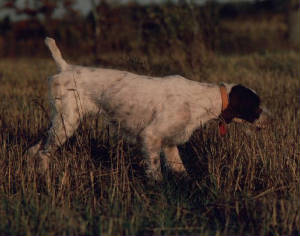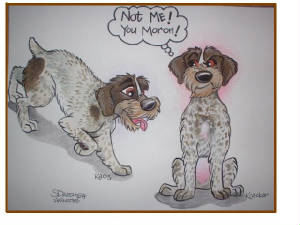The German Wirehaired Pointer breed standard places great emphasis on coat. It states, "A dog must have a corret coat to
be of correct type". As breeders, we strive to produce the ideal coat. In reality, we know that this very important quality
can be inconsistent. The standard also places a severe penalty on "extreme and excessive grooming". This guide is not meant
to encourage the presentatio of overly groomed dogs. It is intended as a basic outline on how to trim. Therefore, depending
on the amount of coat your dog has, its texture and how quickly the coat replenishes itself, you may use this outline in whatever
way it applies to your individual dog.
The Wirehaired coat on a GWP is, perhaps, the Breed's most distinctive feature. The dogs were originally bred to be all-purpose
hunting companions, finding fur and feather on varried terrain and retrieving in water and on land. The top coat should be
harsh and flat-lying, weather resistant and to some extent water repellent. A GWP coat is often confused with a terrier coat.
The nature of our dogs coats is different from that of a broken-coated Terrier (i.e. Airedale). The softer undercoat changes
with the seasons, becoming dense in the cooler Fall and Winter months and shedding or thinning during the Spring and Summer.
Terriers ordinarily do not shed out their undercoats. A correct GWP coat doesn't curl or "open up" after a day in the water,
the way a Terrier coat might. While the coat of a German Wirehaired Pointer might not have as harsh or tight of a jacket as
a Terrier, it also should not have the maintenance of a Terrier coat. The head coat should be naturally close fitting, while
the coat around the shoulders and over the croup tends to be slightly thicker then the rest of the body coat. Furnishings
should be of moderate length and wiry enough to protect sensitive areas from sharp branches, thorns and burrs. A short, smooth
coat is not protective, and a soft woolly coat and profuse furnishings. They only countereract their original purposes
by attracting dirt and debris. A correct Wirehair coat should be funtional and low maintenance.
Tools : Besides a good comb and brush, there are two basic tools that are useful. The first is a
medium to fine-toothed terrier stripping knife (i.e. Gately, McKnyfe, Pearson or Twinco), used primarily for taking down the
coat. The second is a fine-toothed rake (Hauptner Real) for removing unwanted undercoat.
How to : A good time to start working your dogs coat is when it is blown. It will look unkempt and
scraggly and lift up in strange directions instead of lying flat. At the same time, the furnishings will usually look limp
rather then "standoffish" and sometimes the beard and eyebrows appear bleached out. Now is the time to take the entire body
coat down from the head to the tail, including the hindquarters, leaving only the eyebrows, beard, chest and leg furnishings.
Hold the stripping tool in your palm, grab a small amount of hair between your thumb and the blade of the knife. Pull the
hair out in a quick, straight motion in the direction it grows. At the same time, grab the dog's skin above the area
you are working on in order to give yourself some traction. Proper stripping will never hurt a Wirehaired coat -- it will
encourage better growth and correct texture. If our dogs were frequently running in heavy cover, this job would be done naturally.
At first you may find trimming to be difficult. Don't hesitate to spread the work out over several days time.
The next step is to take care of the primary work on the furnishings. Comb the feathering on the dogs legs up and
out to the sides. Remember, the furnishings need not be profuse, only protective. With your thumb and forefinger, pull out
any hair that is long or limp. The furnishings should be short enough and have enough texture to stand off the legs a bit
in order to catch burrs, twigs and any other potentially harmful debris. Pull any discolored or overly long hair from the
beard and eyebrows in the same way. Pull only a small amount at a time to avoid overdoing it. Fine finishing and blending
will come later. Keep the coat on the cheeks short, while leaving everything inside an imaginary line from the outside corner
of the eye to the corner of the mouth pretty much as is. Excessively long hair on the ear leather should be removed, leaving
only a fringe if you desire. Now look at the dog from the front. Chest furnishings should not extend from shoulder to shoulder
like a skirt. This will only detract from the dogs movement. Furnishings should begin at the sternum and extend down between
the dogs forelegs and blend into the hair on the underside of the chest.
After this initial stripping job is done, just brush your dog to stimulate the natural coat growth. In about three weeks
time, you may notice undercoat sticking out through a fresh growth of wiry top coat. You may carefully remove this by gently
plucking it with your fingers or your stripping knife. It should come out very easily as this is blown undercoat. Approximately
eight weeks from the initial stripping (amount of time can vary from 6 - 12 weeks) the coat should be looking just about
right. When it looks its best to you, that is the time to start "rolling" the coat. This means to pull off a small amount
of top coat at staggered intervals so that there is always a fresh wiry coat coming in to replace the blown or dead hair.
Every two weeks, depending on your dog's coat, it's length and how fast it grows, pull a scant layer off the entire
body. You only want to "top" the coat, not take it all the way down. Also, use the fine-toothed rake to remove any blown undercoat.
This tool is more or less used to comb the coat (holding the tool almost parallel to the body). Do not use this tool to strip
or pull coat out! Just rake it through the coat. There are certain areas on the dog that you always want to remain short,
such as the underside of the neck, from behind the beard to the sternum, the hindquarters when looking at the dog from the
rear and to some extent, the point of the shoulder. Keep these flatwork areas in mind when you do your weekly grooming. Continue
brushing and raking as before as well as topping the body coat every so often to keep it in shape. Leg furnishings, eyebrows
and beard shoud be picked through bi-monthly to remove and dead hairs.





